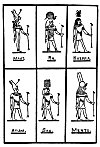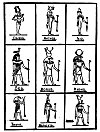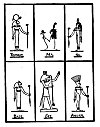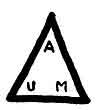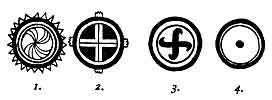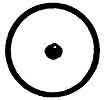NONE of the prehistoric races that have inhabited North America have caused more interest and speculation than the Mound Builders. Among their remains, in their mounds and burial grounds, have been found pottery of a high order, bone needles with eyes, stone pipes with elbows, strings of fine beads made from shells, fragments of cloth, ornaments of catlinite, silver, copper and tortoise shell, and some strings of extraordinarily large pearls, etc.
1
On their ornaments and pottery are found various religious symbols, connecting them with a prehistoric race in Mexico and with Mu, the Motherland of Man. By these symbols it is shown that they possessed a highly scientific knowledge, for they perfectly understood the great Cosmic Sciences which today are just dawning on our scientific world. The Cosmic Sciences include the origin and workings of the Four Great Primary Forces, the parents of all forces. My object is not to attempt to give a history of the Mound Builders but simply to give some of the high lights about them which
p. 219
apparently have been overlooked by the archaeological authorities who have been keeping the public informed regarding the mysteries of the Mound Builders. My object is to show their great civilization, which I think has been underestimated, and that they came from Mu via Mexico.
Regarding the time when they were living in America I have found nothing whereby even an approximate date could be suggested except that it was
after Atlantis went down about 11,500 years ago. My opinion is that they were among the last of the prehistoric races that can be called prehistoric.
Geographically they occupied what may be termed the Mississippi Watershed. This area before the sinking of Atlantis was a shallow inland sea extending north from the Gulf of Mexico. The sinking of Atlantis in the Atlantic Ocean formed an immense hole in the Atlantic. To fill this in and level off the waters the surrounding waters were drawn in. This drew off the waters from various shallow inland seas, made them either dry habitable lands, or swamps. It also extended the coast lines. During the process of the readjustment of the waters the Mississippi Valley was drained. Even after the land was drained it was a long time before it assumed a condition where man could live and thrive upon it. This condition seems verified by the fact that no remains of the Cliff Dwellers, or those that preceded them, have been discovered in the Mississippi Valley proper.
p. 220
The end of the Mound Builders, like the Khymers of Cambodia, apparently came very suddenly, leaving no trace behind it. While the Mound Builders show no cause for their apparent sudden disappearance the Khymers do, for it is geologically shown that the Khymers were destroyed by a flood, a cataclysmic wave having rolled up the Meikong River and surrounding Khymer country.
The Mound Builders as a people are gone, but did they leave no descendants in America? If Sacred Symbols, which I have found the most reliable source with which to trace the movements of people from time to time, are acceptable (I say this after fifty years of study), then we have something with which to make a start. This, with other evidence which may hereafter be found, may eventually show that they have descendants still among us in some of the Indian tribes of our southwestern states.
Fig. 1. Is a bottle recovered from a mound on a line between Southeast Missouri and Arkansas. Therefore, this is of ancient workmanship.
Fig. 2. Is a water bottle I personally own. It was bought from Indians in New Mexico within the last ten years and was perfectly new when given to me. This, therefore, is modern. The main figure on each of these two bottles is identical, with the exception of coloring. The ancient has a creamy white ground with brilliant figures. The modern has a brick red ground with black figures edged with white.
p. 221
The symbol referred to is the same, line for line, and is an artistic design of the cross symbolizing the Sacred Four, the Four Great Primary Forces. The lines of the cross are drawn to extend in westerly directions, thus running from west to east. This is also shown on some of the Mexican tablets.
There is evidence that the Mound Builders of North
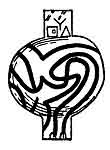 1. 1.
Ancient
|
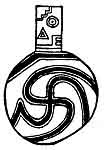 2. 2.
Modern
|
[paragraph continues] America had an advanced knowledge of the Cosmic Forces which they could have attained only by some connection with, or direct, from the Motherland. Thus it is shown that their forefathers came from Mu, but by what gate did they enter America? I find among the traditions and lore of the Indians who now are on the lands where the mounds are found that: "
The Mound Builders came to the Mississippi Valley from Mexico." Can these traditions of the Indians which say that the Mound Builders came to North America from Mexico be proven?
p. 222
I already have shown one example where an ancient prehistoric people of Mexico had the same symbols as the Mound Builders, conveying identically the same meaning in both cases. By comparing other symbols of the Mound Builders with those found carved on Niven's Mexican tablets it appears to show some definite connection between them, and that these Indian legends are history, orally handed down.
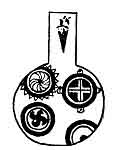 Water Bottle
Water Bottle
From a mound, Mississippi County, Missouri
As an example, I will take the symbols found on another Mound Builder's water bottle and compare them with some of the symbols on the Mexican tablets. Here we find an exceedingly strong link connecting the American
[paragraph continues]
p. 223
Mound Builders with the prehistoric race of Mexico, heretofore referred to.
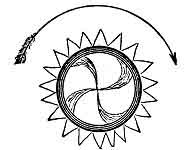 Symbol of the construction and workings of the Sun
Symbol of the construction and workings of the Sun
This symbol is one of many found on a Mound Builder's water jar in Mississippi County, Missouri, and is a diagram showing how the Forces of the Sun are generated and carried throughout the Solar System. The dissection of it shows:
That the Sun has a hard crust and a soft center.
That the Sun is being revolved by her Superior Sun from west to east.
The revolving hard crust carries around the soft center in the same direction, but not at the same velocity, thus forming a frictional line, a magnet. This is shown by the soft material in the center being curved.
It is shown to refer to the Four Great Primary Forces by the central soft material being divided into four arms forming a cross, the first and original symbols of the Four Great Forces.
p. 224
The form of the rays of the Sun are in the shape of the symbol for activity, thus saying that the rays are active in carrying the Forces somewhere,
i.e., the generated Forces are taken from the hard crust by the rays and delivered in a manner to carry out certain functions not shown in this diagram.
This diagram of the American Mound Builders is the only one I have come across so far that fully carries out the writings about this phase of the Sun, which are found in the Books of the Golden Age, and thus showing the excellence of the scientific knowledge of the Mound Builders of America. Many of the Mexican tablets give parts of it but none in whole as does this one. Writings from Egypt show that they understood the Cosmic Forces in 1200 B. C., but how much later I cannot say.
The Mound Builders of America date back to when? This brings forward a question--since when were the Cosmic Sciences lost to the world? Yet, they have never been entirely lost. The old Rishi understood them. Scraps of them still are known in the Orient and among the Polynesians, and I am not so sure that some scraps are not known among some of the tribes of the North American Indians. I have good reasons for saying this. In this diagram the Sun is drawn as representative of Kin, the Celestial Orb, and not as Ra, the monotheistic symbol of the Deity.
The foregoing are definitely the teachings found in the Sacred Writings.
p. 225
This is a compound cross symbolizing the Sun as the Celestial Orb with a white cross in the center surmounted with a red cross. The white open cross reads
U luumil, which translated is the Country of, the Land of, the Empire of--and being within the Sun, reads--the Empire of the Sun, Mu.
The plain cross surmounting the white open cross is the oldest and original symbol for the Four Great Primary Forces, sometimes depicted with the Swastika, subsequently termed the "Good Luck" symbol.
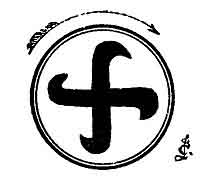 Mound Builders Mound Builders
|
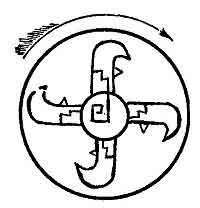 Mexican Mexican
|
Showing the Four Primary Forces moving from West to East
I have selected just one of the Mexican Tablets to show beside a Mound Builder's symbol, Niven's No. 1331. I have taken this Mexican tablet for comparison as I have hitherto, in various of my writings, stated that this tablet was one of the most important among
[paragraph continues]
p. 226
Niven's collection of over 3000, and one of the most important finds in any part of the world.
In both cases the Mound Builders and the Mexican show the Four Great Primary Forces emanating from the Creator, and are said by the ancients "To be His commands, His desires, His wishes." They are, in both symbols, shown moving from west to east, thus causing the whole universe to revolve from west to east, and all living moving spheres to revolve on their axes from west to east.
This is a universal symbol found in all ancient countries throughout the world. It is a picture of the Sun as Ra, the monotheistic symbol of the Deity.
MOUND BUILDERS' SYMBOLS.--
Line 1. Figs. 1 to 5. All these symbols are pictures of the Sun, and are universal, that is, they are found among the writings of all ancient peoples.
Line 2. Figs. 6 to 10. These five symbols are all recording the Four Great Primary Forces, and that they emanate from the Creator. Figs. 6, 7, and 8 are frequently found among Niven's Mexican tablets, and in the Mexican they are always shown as originating from the demand or order of the Creator. Figs. 9 and 10 are more universally found among ancient writings.
Line 3. Figs. 11 to 15. These figures symbolize the
p. 227
p. 228
earth's Forces and their origin and the manner in which they work. Figs. 11 and 12 are skeleton, or outline, drawings of 13 and 14. These four figures show the earth's molten center being carried around and grinding against the earth's hard crust. This grinding forms a frictional line between the two, which in turn forms a magnet. The magnet has two divisions, one affecting Forces, the other, elementary matter. The Division, having control over elements, is what is commonly known as the Force of Gravity, therefore, what is known as the Force of Gravity is the power of the Cold Division of the Earth's great Central Dual Magnet. The Division, having power over Forces, affects the
Earth's Forces only. It has no control over any Forces emanating from beyond the earth's atmosphere. Fig. 15 shows the earth's Forces passing out of her body into the atmosphere (they are thus drawn out by their affinitive Forces carried in the Sun's rays). Earthly Forces like elements become exhausted, and when exhausted the Sun's affinitive Forces have no further attraction or control over them. The Central Magnet then proceeds to draw them back into the great frictional line where they are regenerated and again sent to perform the duties required of them by nature. I may say further that this example of the workings and origin of earthly Forces may also apply to all revolving bodies throughout the universe, and thus show that a single Divine system is controlling the Universe.
Line 4. Figs. 16 to 20. These are also symbols of
p. 229
the Four Great Primary Forces. Figs. 17, 19 and 20 are shown as emanating from the Deity. Fig. 16 is the original and oldest symbol for the Sacred Four or the Four Great Primary Forces as it is found in the Sacred Writings of Mu, which are more than 70,000 years old.
All of these symbols are found embodied in the Mexican tablets. Fig. 19 is an exact duplicate of what I have heretofore given as the Pyramid Cross.
Line 5. Figs. 21 to 24. In this line I shall note only one figure, 22. The others are common and universal. Fig. 22 is a very rare symbol. I have found only one duplicate of it, and that is the Hindu writings of about 4000 to 5000 years ago. This figure symbolizes the Sun sending forth his rays throughout his System (the solar). They are shown as being of two varieties--dark and invisible because of their intensity, and light, which are apparent to vision. The rays are in the form of Forces, as shown by the Force symbol. Again they are curved, pointing to the east and thereby telling us that they are working from west to cast and forming a circle. As they are taking a circular route all rays coming from the Sun would not strike the earth in a straight line from the Sun but in a curve.
This again shows that our prehistoric Americans were further advanced in science than we are today. Do our present scientists appreciate this fact? Does this not show that we are thousands of years behind in our knowledge of science, based on theory alone? Personally, I think so.
p. 230

Click to enlarge
A Mound Builder's Calendar Stone Found in the Ouachita River, Hot Springs, Arkansas
From Col. J. R. Fordyce, Little Rock, Arkansas
A MOUND BUILDER'S CALENDAR STONE.--
Dimensions. The stone is pear shaped. Length about 16 inches, and about 13 inches across at its widest part. "It is a sandstone bowlder such as found in shale near Hot Springs. It weighs 22½ pounds."
Description. In the center is a slightly raised ring 7¼ inches in diameter. This ring is divided into thirteen equal divisions. On each division is inscribed a figure or a glyph. Superimposed on this circle is another which is much higher. This, I presume to be meant for a picture of the Sun, as the symbol of the Deity. Above this main figure is engraved a caption, the Moon in its various phases during a calendar month. This tells us the meaning of what is below, namely: the circle with the thirteen divisions represents thirteen calendar months, making one year. The thirteen
p. 231
months, forming a circle, tell us that the year is completed, the beginning and the end. Over the caption is shown the All Seeing Eye looking down from heaven above. This is an ancient symbol dating back to the earliest writings, and universally found. Outside of the calendar proper, to the edge of the stone, various animals are shown, including Man.
The Calendar Glyphs.
1. This is too indistinct to say positively what is meant or represented. However, it appears to be a bird with wings outspread. If this is correct, then it probably would be the American Indian Thunder Bird.
2. This seems to portray the Maya month of Zac, the white month, when snow covers the ground with a white blanket.
3. This is a new symbol to me. I do not know its meaning.
4. This is a fish which is symbolically heading upstream, denoting that during this month fish are most plentiful, the time when they make their spring run up to their spawning beds.
5. This glyph is one of the letters in Mu's alphabet. It has an esoteric meaning.
6. This is a picture of the Sacred Lotus flower, Mu's floral symbol. The lotus was the most beloved and revered of all Mu's symbols. The Egyptians always ref erred to Mu as the Lotus.
7. Without this is a line drawing of the head of the Mound Builders' conventional serpent. I do not know
p. 232
what it is. Among the etchings at the Pipestone Quarry, Minnesota, there are some that are almost identically like it. The Pipestone are without question the heads of the Serpent.
8. This is a sacred symbol common in Oriental countries. Once, and only once, before have I found it in America. That was among the Mound Builders' remains taken from one of their burial grounds. It is one of those ancient religious symbols whose meaning was lost when the Brahmins persecuted and drove their teachers, the Naacals, out of India into the snowcapped ranges of the Himalayas about 2000 to 2500 B. C. The meaning of the symbol is expressed in four words of the ancient tongue. These words were used before the commencement of a supplication, or prayers. They are being repeated to this day but the priesthood does not know their meaning. The meaning of AUM was forgotten about the same date. So far in months 6 and 8 we find a direct connection between the people who made this calendar stone and the
Mound Builders,
Mu and the
Orient.
9. This glyph is new to me. It appears to picture ripe grain being cut and harvested. The time on this stone is given about August or September. It would thus correspond with harvest time when grain is reaped and stored.
10. This symbol is frequently found in ancient writings. It pictures the fall of the year when trees and
p. 233
shrubs shed their leaves, leaving the branches bare and leafless.
11. This is one of the most conclusive symbols on this stone and directly connects the makers of this stone calendar with the
Mound Builders, the
Polynesians, and therefore,
Mu, as their ancestors came from the Motherland. The symbol is the Grey and Black Pointed Spider, which is discussed later in this chapter. I have received information that similar spiders have been found among the treasures recovered by Schliemann in ancient Troy, Asia Minor. These, however, I have not seen.
12. This symbol is questionable. Is it the outline of a deer?
13. This is certainly an outline drawing of a bison. It is now the last month in the year, the head of this buffalo is pointing in. Is this the time of the year when food has become scarce further north and he is now working in to the south where conditions for the time being suit him better? I think so. The same question applies to the 12th, the deer.
Comments. There are various animals shown on the outer side of the stone. These I have not taken into account although two are very prominent in ancient picture writings and in Indian legends.
It must be apparent that the designers of this Calendar Stone were acquainted with the Cosmic Forces and the Cosmic Sciences as taught during the First
[paragraph continues]
p. 234
Great Civilization. Therefore, America at one time was enjoying the highest civilization the earth has ever known.
THE GREAT SERPENT MOUNDS.--The feature which has captivated the public interest most in the Mound Builders is their great serpent-shaped mounds. That these serpent mounds were symbolical there can be no doubt. Serpents of various patterns and designs have always, from the beginning of religion, played an important part in religious ceremonies, not among one particular race but among
allancient people from the time symbols were first used.
One of the most important of the American Serpent Mounds is situated at Brush Creek near Peebles, Ohio. I cannot say definitely in what way this Serpent Mound was symbolically used--whether as the Seven Great Commands of Creation, the Waters, or the destruction of Mu, the Motherland. Possibly it may have included two of the foregoing. That it, or ceremonies connected with it, referred to Mu there is ground for belief for the following reason: it is stated that some of the Serpent Mounds have sacrificial stones or altars upon them, with the possibility that all had them originally. As Mu went down it was into "a fiery abyss," fires of the underneath. It became a custom among all surviving peoples thereafter at various times and occasions to commemorate her destruction by fire. Fire is shown to have been used in commemorative services by the Mayas and Quiches who had their fiery house, and the
p. 235
Egyptians who used a fiery tank, and others who used burnt sacrifices of some description.
In England near Stonehenge there is a Serpent Mound said to be an exact duplication of the American at Peebles, Ohio. Thus, we find in England a specialized symbol of the same as used by the Mound Builders of America, and in both cases the same meaning and conception is conveyed. What is a reasonable deduction? Common origin, without doubt. By what route did the Mound Builders get into England? It is questionable when we trace the various symbols that have been found in England, and the still more pronounced display found in Egypt.
SPIDERS.--While the great Serpent Mounds have captured the most public interest among the Mound Builders' relics, the Spiders have the greatest fascination for me, personally. While exploring among the South Sea Islands some fifty years ago I constantly came across legends about the Grey and Black Pointed Spider. These legends showed that the Spider was symbolic of something, and that it was a sacred symbol,
p. 236
but of what I could not determine. The legends were all too obtuse. As examples:
"There the Grey and Black Pointed Spider would have mounted to Heaven, but he was held back by the bitterness of the cold."
"The roads were cunningly constructed to represent the web of the Grey and Black Pointed Spider, and no man could discover the beginning or the end thereof."
Now after waiting fifty years and having given up all hope of ever solving the riddle of the Grey and Black Pointed Spider I find the answer given at our very doorstep. Truly, here in America lies the key to unlock the great past history of man.
These Spiders were brought to my notice by my friend, Dr. Thomas M. Stewart, of Cincinnati, Ohio. They are engraved on circular pieces of shell, and on each of their backs is a symbol showing what they represented. These peculiar relics have been found in the burial vaults of the Mound Builders of Missouri, Arkansas and Tennessee. Because of the location of the places where they have been found Dr. Stewart suggested that they might have been used in the same manner as the Scarab in the Egyptian burial chambers.
The symbols on the backs of these Spiders are duplications of the symbols found as ornaments on the Water Bottle shown on page
241. No. 1 is the original symbol for the Four Great Forces shown in No. 2 on page
241. No. 2 shows the Forces working from west
p. 237
to east as in No. 3 on page
241. No. 3 is the same compound symbol as shown in No. 2, page
241.
Some of these symbols are shown on pottery recovered from the ancient ruined cities in Crete, Cyprus and ancient Troy
1 in Asia Minor.
Although exceedingly rare, I think that the Grey and Black Spider, as a symbol, had a wide range at one time and we still may find many of them on pottery that have been overlooked because their import was unknown.
I think that the foregoing bears out my assertion that merely digging up old remains, symbols, inscriptions and writings is not archaeology, that archaeology is the reading of these symbols and writings when found. A builder, digging a foundation for a structure, who unearths a stone bearing an ancient inscription does not make the builder an archaeologist--he is only a builder. A farmer, ploughing his ground, turns over an old stone with an inscription on it. This does not make the farmer an archaeologist--he is only a cultivator of the soil. Or his son may be digging potatoes and unearth an old piece of pottery. The son is only a potato digger, not an archaeologist.
The Mound Builders' Symbols, before they are read, are only artistic ornamentations and mean nothing, just potatoes on a piece of pottery. But, when read, they may give a line on a page of the early history of North
[paragraph continues]
p. 238
America by telling us that a mysterious race called the Mound Builders, who once occupied a part of our land, originally came from Mu via Mexico, that they were a highly civilized and enlightened people, having a knowledge of the Cosmic Forces and their workings, thus showing that they had a scientific knowledge greater than we have today.
THE OCTOPUS, A SACRED SYMBOL
THE OCTOPUS.--The Octopus is one of the very rare sacred symbols. By this I do not mean that it was seldom used, but that only a few symbols of it have been found. As a matter of fact I think it was a very common symbol among some of the ancient peoples. At present when found, generally on pottery, archaeologists have looked upon them as mere decorations and ignored the fact that many of the specimens show, without a doubt, that they were sacred symbols.
The Octopus is often found on the ancient Greek pottery. It was used in Peru, Brazil, North America, Greece and Scandinavia until a few thousand years ago. Judging by the way it was used it was the symbol of a
Water Demon, the Enemy of Life. Its rôle was to prevent the advent of life on earth.
Most of the ancient writings telling about the advent of life on earth symbolize it in such a manner that it represents a battle between the Sun and the Waters for supremacy over something, but does not say what that something is.

Click to enlarge
Vase of the Late Minoan I Period (about 1600-1100 B. C.) found on Gournia, Crete
Courtesy of the Metropolitan Museum of Art.
For example: the Babylonians say Belmarduk, the Sun, fights Tiamet, the Waters. From a Cuneiform Tablet-"The gods are preparing for a grand contest against the monster, Tiamet." "The god Belmarduk overthrows Tiamet." The Egyptians have it that Horus, the Sun, overcomes and kills the serpent Aphopis, the Waters. The Hindus say that Krisna, the Sun, destroyed the serpent Anatha, the Waters. And the Greeks record that Apollo, the Sun, overcomes Python, the Waters. The Fifth Command of the Sacred Writings of Mu is: "And the arrows of the Sun met the arrows of the Earth in
the mud of the watersand out of particles of the mud formed cosmic eggs"--life germs.
From the foregoing, combined with the legends about the Octopus, it appears that the Octopus was the symbol of the
resistance of the mud against allowing the Sun's Forces to draw the Earth's Forces out into the water to form life's cosmic eggs. The Sun's Forces, however, prevailed and met the Earth's Forces and formed cosmic eggs, and life commenced according to Divine Command.
The legends as told today about the Octopus are perfect myths, but by going behind the myth and finding its origin we discover the true legend.
It was very noticeable that wherever a legend is found the phenomenon is shown to have occurred in that particular spot. This is especially so among savage and semi-savage people. As examples: the Fijians have
p. 240
a legend about the "Tower of Babel." According to them the "Tower of Babel" was being built on one of the Fijian Islands. The Fijians are courteous to visitors and will take anyone gladly to the spot where it stood. The Polynesians have a legend about the "Ark." They claim that it was built on one of their islands. The Maoris have a legend about "Cain and Abel." They tell you that Cain and Abel were New Zealanders and that the murder of Abel occurred in New Zealand.
The symbolic Octopus, like the Sun, is known by many names, its name being taken from the language of the people where it is found. With all people the Octopus was a
Water Demon and
the Enemy of Life. It had no other meaning.
SHADOWS FROM GREECE AND ASIA MINOR.--From the ancient cities of the Grecian Archipelago and Asia Minor, which have been and are being unearthed, many pieces of pottery have been found which have the Octopus either engraved, raised or painted on them, making prominent and striking decorations. In Crete, Cyprus and Troy many fine and perfect specimens have been discovered. Fortunately, the motif designs vary considerably which gives one a fair chance to read their correct meaning, as for instance, on vases B and C in the Cyprus Group. On both the tentacles and body are intact. Here the Octopus is simply a reminder of that which it symbolizes. Vase A, from the same ruined city, shows a totally different phase. Here the Octopus
p. 241
is depicted as having been in battle and got the worst of the encounter. This is shown by his broken and cut tentacles, his fighting weapons.
From where did the Greeks get the octopus? First, the octopus appears to have been one of the symbols used by Mu. From the Motherland it was taken by the Carians into Peru and Brazil. Second, when the Carians, the forefathers of the Greeks, continued their
p. 242
advance towards the cast and finally settled at the eastern end of the Mediterranean they carried their sacred symbols along with them and among these was the Octopus.
I think the foregoing shows sufficient proof that the Octopus was one of the early sacred symbols and that it was carried to the southeastern parts of Europe and Asia Minor by the Carians. But what people carried it to Scandinavia is an open question.
THE PIPESTONE OCTOPUS.--In trying to read this pictograph one apparently is met by three contradictions:
[paragraph continues]
p. 243
First, the Octopus has within the grasp of one of its upper tentacles a Serpent, a specialized Serpent, an exact duplication of one of the Mound Builders' Serpent Mounds. What connection is there between the Mound Builders and the people who carved this rock picture? Were they the same people? Or was this peculiar specialized Serpent used by various peoples and was this picture etched by one of them? The Octopus, having the Serpent within the grasp of one of its tentacles, intimates that the circle from which the tentacles project is the body of the Octopus; but being a circle it is a picture of the Sun. This would suggest that the circle was a Sun symbol and not the body of the Octopus.
Second, as against reading the circle as a Sun symbol we see projecting from the lower side of the circle the beak of the Octopus in the form of the ancient symbol for a cutting or dividing Force. This symbol also appears on the Mexican tablet No. 1584, Woman's Creation. Added to this in the small Fig. B, the Octopus is shown with a real body, nearly round, with the Serpent held in one of the tentacles.
Third, the foregoing shows a possibility that the circle forming the body in Fig. A may actually be symbolizing the Sun's Forces as Kin, the Celestial orb, and not Ra, the monotheistic symbol of the Deity.
One of the difficulties in attempting to read this picture is that the ends of most of the tentacles are so indistinct that their meanings are doubtful. This picture
p. 244
requires a great deal of study with the assistance of other pictures referring to the same subject to obtain the full meaning in detail. The fact remains that it may convey the same meaning as the Octopus on the Cyprus Vase A and many other pictures of the Greeks, Egyptians, Hindus, Babylonians, etc.
At the lower right hand corner is shown either a wolf or a dog. In the Scandinavian myths this dog or wolf plays an important part.
THE PIPESTONE QUARRY.--This quarry in Pipestone, Minnesota, is the oldest quarry on earth to have been worked by man, for it was known and worked back in the Tertiary Era, before the mythical Glacial Period, the last Magnetic Cataclysm.
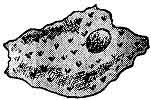 Gilders Pipe, Omaha, Nebraska, over 15,000 years old, made out of the red mottled stone of Pipestone Quarry
Gilders Pipe, Omaha, Nebraska, over 15,000 years old, made out of the red mottled stone of Pipestone Quarry
The age of the Pipestone Quarry is proven by two facts. First, by Gilders Pipe which was found among the remains of man who lived during the Tertiary Era. The clay from which this pipe is made is found only at one spot on earth (as far as is known to geology), and that is at Pipestone. The geological name of this
p. 245
stone is Catlinite. (It has been claimed by some that Catlinite is also found at Feuerte Farm about three miles from Portsmouth, Ohio. The only way that this can be decided satisfactorily is by comparing the chemical analysis of the two--the Pipestone deposit and that found at Portsmouth.)
According to Indian traditions the location of the Pipestone Quarry was lost for a long period of time. Its rediscovery forms one of the Sioux legends. The Indian legends about the Pipestone and other subjects are fascinating, and when shorn of their mythical adornments tell us that the first Americans came from Mu, which adds another link to the overwhelming chain of evidence that America was Mu's first colony and that America today is the oldest land above water that has been inhabited by man. America antedates Atlantis, Egypt, Greece, Babylonia, India and. all other ancient nations. The Pipestone Indian legends also show that the first Americans were highly civilized people, and that they came from a land in the west beyond the Setting Sun.
In reference to the rediscovery of the quarry, Omaha and Yaukton Indian legends relate that "Walregela, the Omaha wife of a Yaukton Sioux, following the trail of a white bison discovered the Pipestone on the banks of the Pipestone Creek, where it had been ex posed by the bison s hoofs."
Extracts from Chon-oopa-sa.--Legend by Pa-la-nea-pa-pe (Man that was struck by the Ra).
p. 246
The Advent of Man
"In the far off past
A million, million, million moons ago,
The first of mortals to this earth below
By great Wo-kon was cast:
The first Dakota moulded from a star
He tossed and watched him fall
Down through the dark, till he alighted there
Upon soft ground. He was not hurt at all
And Wa-kin-yan, first Sioux."
"He ranged the land in hunting many a year
Until at last this solitary man"
"
Where afar we see the sunset
Summer days in golden glory
In
the mystic land of legendIn that far land of
the westLand of Red-man's home and story.
Land of legend, strange tradition,
Vale of dim
unwritten hist'ry."
The Woman
"And Wa-kin-yan prayed hourly (never tired . . .
Wa-kon to send him what he most desired . . .
And Wa-kon heard his pleading,--broke a beam
p. 247 At noon from off the blazing summer Sun
And moulded, fashioned-beauteous as a dream,--
The first of all her sex-the longed for One!
. . . Sweet Co-tan-ka--"
The Demon Octopus
"Wi-toon-ti, he that stayed
By day in the river's
mud."
"Wi-toon-ti, he that feared
Wa-kin-yan's bow and shaft."
"A monster he."
"Then Wa-kon-da, vengeance taking
For the murdered Sunbeam's daughter."
"Then he seized a blazing tail star
Formed another mighty arrow
Sent it flying to Wa-kin-yan."
"The Wa-kin-yan rose up quickly
By the blazing shaft he sighted!
Twang! behold it forward flying
See it flare and flash and hurtle
Through the rain of fiery sparks
Through Wi-toon-ta . . ."
p. 248
[paragraph continues] This appears to me to be another version of the fight between the Sun and the Waters, for the creation of Life, so frequently found in the ancient writings on the Creation.
While other Indian legends refer to Mu none of them say what she and her people were like or where she lay except that she was "Beyond the Setting Sun." This Sioux legend goes further--it describes the land as being tropical "Summer days in golden glory." That the teller of the legend was cognizant of the fact that Mu had disappeared and was no more is shown in the passage, "The mystic land of legend." It also tells us that legends about her greatness and civilization were being orally handed down. "Land of Red-man's home and story" informs us that the Indians know that originally they came from Mu. "Dim unwritten hist'ry" tells us that as far as the Indian knows there is no written history of Mu, only legendary.
Another interesting bit of Pipestone lore is the symbolic Bird of Creation. Here at Pipestone among the Sioux legends we again find the Bird of Creation the symbol of the Creative Forces throughout the world. Catlin, in 1836, recounting his visit to the Pipestone, says: "Not far from us, in the solid rock, are the deeply impressed footprints of the Great Spirit in the form of the tracks of a Great Bird. (See Fig. C. Page 242.)
The following are extracts from a Sioux legend: "
'Before the creation of man, the Great Spirit, whose
p. 249
tracks are yet to be seen on the stones of the Red Pipe in the form of that of a great bird."
"Here the Great Spirit used to slay the buffaloes and eat them on the edge of the rock. The blood running over the rocks turned them red."
"One day a large
snake had crawled into the nest of the bird to eat his eggs. One of the eggs hatched out in a clap of thunder, and the Great Spirit catching hold of a piece of pipestone to throw at the snake (here part of the legend missing) moulded it into a man. The man's feet grew fast in the ground, where it stood fast for many ages like a great tree, therefore he grew very old. (In all of the ancient pictures of Mu she is depicted as a very old woman.) At last another
tree grew up beside him when a large
snake ate them both off at the
roots and they wandered off together. From these have sprung all the people now on earth." Here we have two of the ancient writings merged into one--the Advent of Man on Earth, and the Destruction of Mu.
Although no particular name has been given to the Great Bird in this Sioux legend beyond the Great Spirit I think that by its connection with thunder it was the Thunder Bird of all the Indians to the west of the Sioux and was, as told by the old Hayden chief, the symbol of the Creative Forces. The Great Bird eating buffaloes is without question a perfect myth invented by some old Medicine Man to save his face
p. 250
when pressed by his followers to account for the pipestone being red. The legend says
before man came on earth the Great Spirit used to slay buffalos to eat. First, spirits do not eat anything material. Second, it occurred before man was on earth, "A million, million, million moons ago." And third, the buffalo is a recent addition to the picture gallery of life of America.
Man first appeared on Mu. One of the names given to Mu was the
Tree of Life. In this legend the man and the tree are combined in one. Yet this is not so far wrong, for the Sacred Writings of Mu tell us that Mu was the Tree of Life and that Man was its fruit. This is corroborated where the Sioux legend tells of a great
serpent biting off the trees at their roots. A serpent was always the symbol for the waters and when Mu was destroyed she was swallowed by the waters. Biting, in the Sioux legend, is a correct word to use symbolically, for Mu was certainly bitten off from the rest of the land above water. "From these have sprung all the people that now inhabit the earth" clearly shows that this refers to the migrated children of Mu and is confirmed by the saying, "They wandered off" for they had left the land of their birth where they grew up, to go to other lands where they might find living easier.
All extracts, pictures and information about the Pipestone are taken from a booklet entitled,
The Pipestone Indian Shrine, by Miss Winifred Bartlett, President of the Pipestone Indian Shrine Association, who kindly and courteously sent me the booklet from which
p. 251
to make notes, with a view of placing America where it belongs on the ancient map, and to give the Redskin his just due. The translations of the Indian legends are by D. Ivan Downs.
Footnotes
218:1 The pearls, fragments of cloth, ornaments of silver and copper were found in the Bainbridge Mound in Ohio.
237:1 Schliemann's "Treasures of Priam."
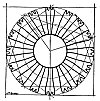
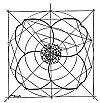
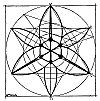
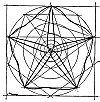
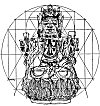

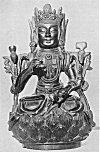
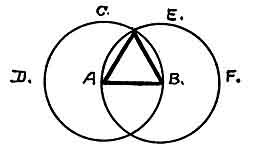
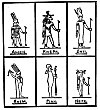
 He had many titles; one was: "The Father of beginnings." The Greeks considered Ptah the same as their Vulcan His name, peculiar to Memphis, was Ptah-Sokar-Osiris. The regular Egyptian name, however, was Ptah-Sekar-Usar. His color was blue. Ptah was without doubt the symbol of the Four Great Primary Forces--The Sacred Four.
He had many titles; one was: "The Father of beginnings." The Greeks considered Ptah the same as their Vulcan His name, peculiar to Memphis, was Ptah-Sokar-Osiris. The regular Egyptian name, however, was Ptah-Sekar-Usar. His color was blue. Ptah was without doubt the symbol of the Four Great Primary Forces--The Sacred Four.